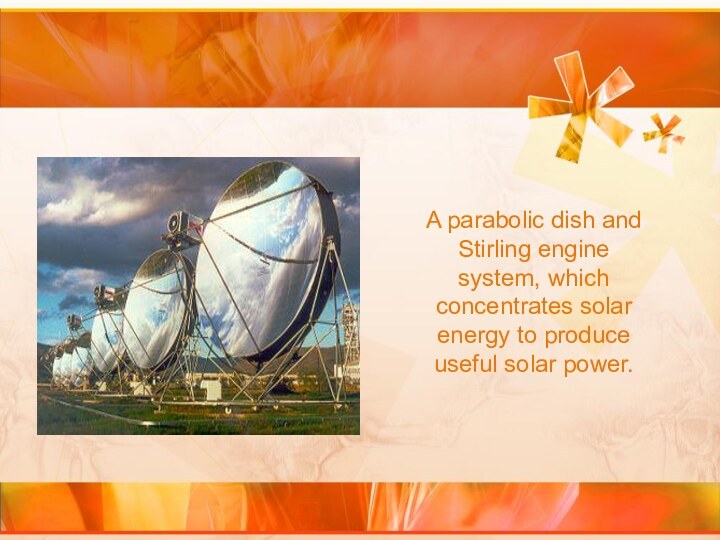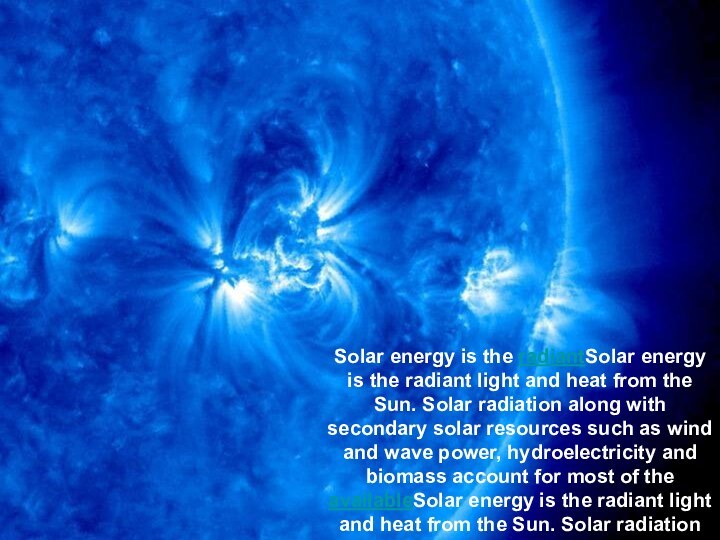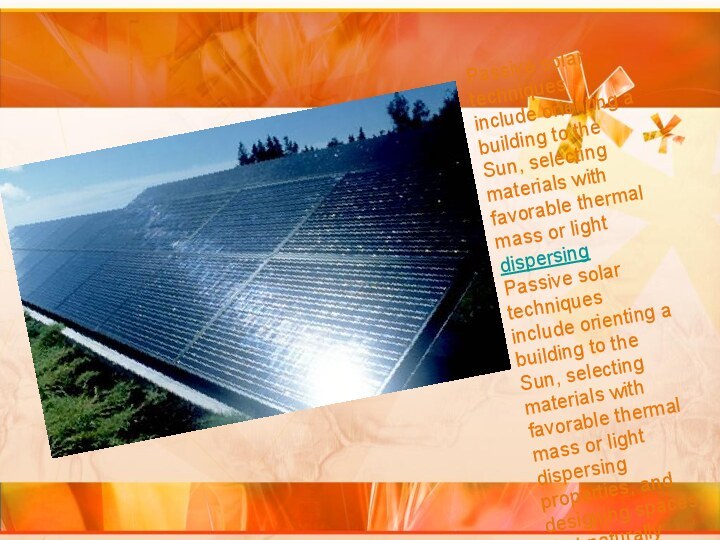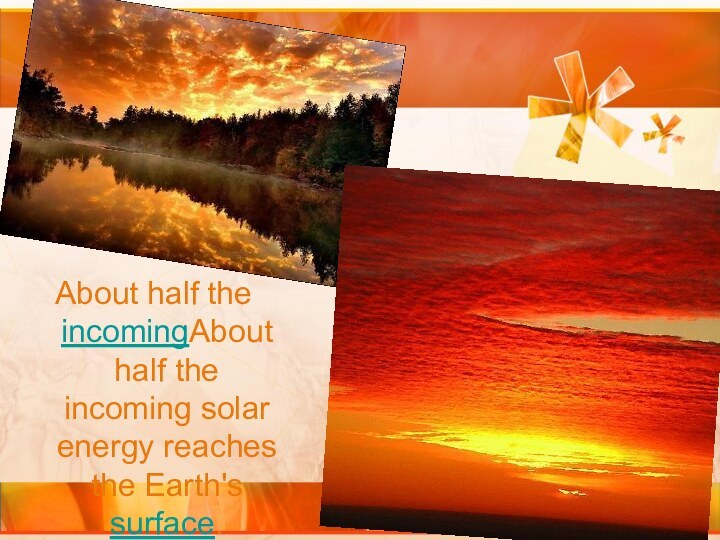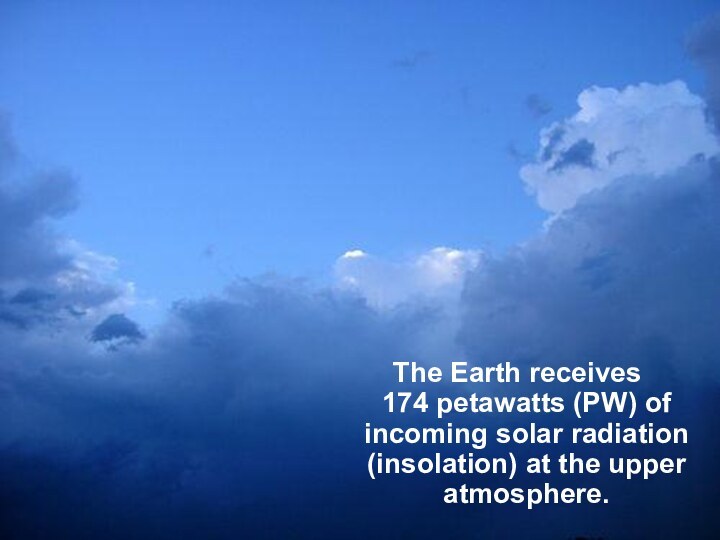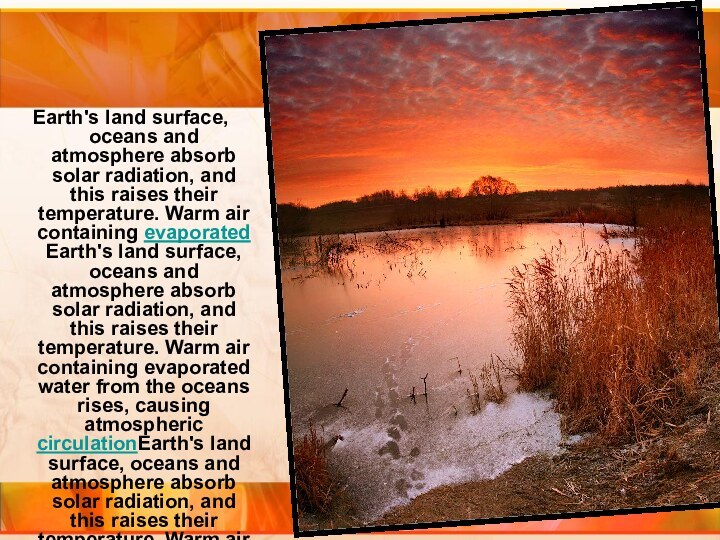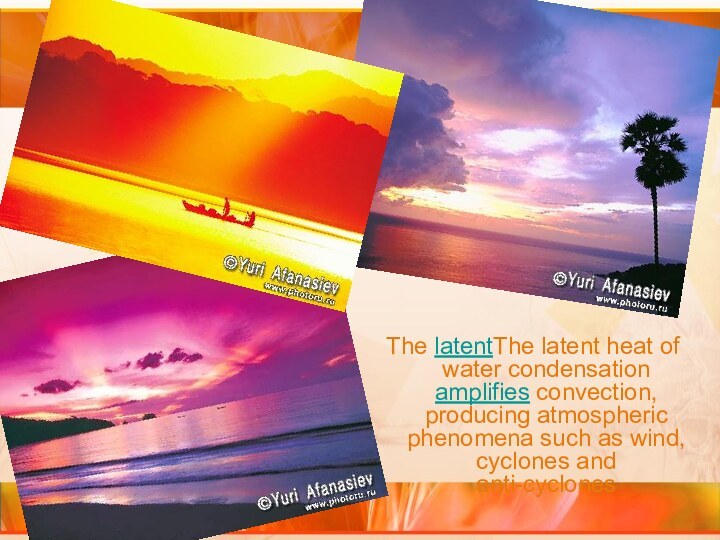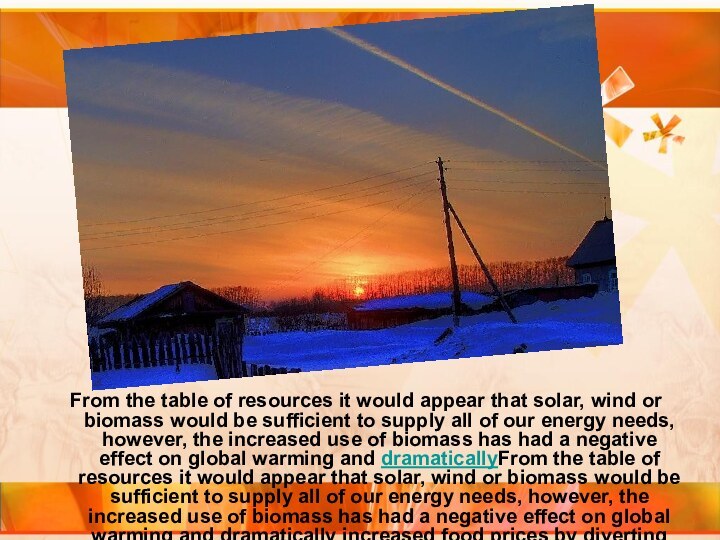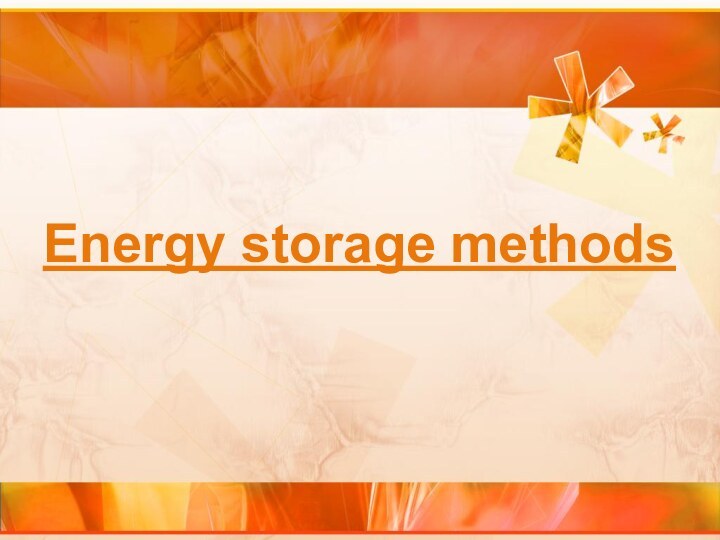Слайд 2
References:
1. Agrafiotis, C.; Roeb, M.; Konstandopoulos, A.G.; Nalbandian,
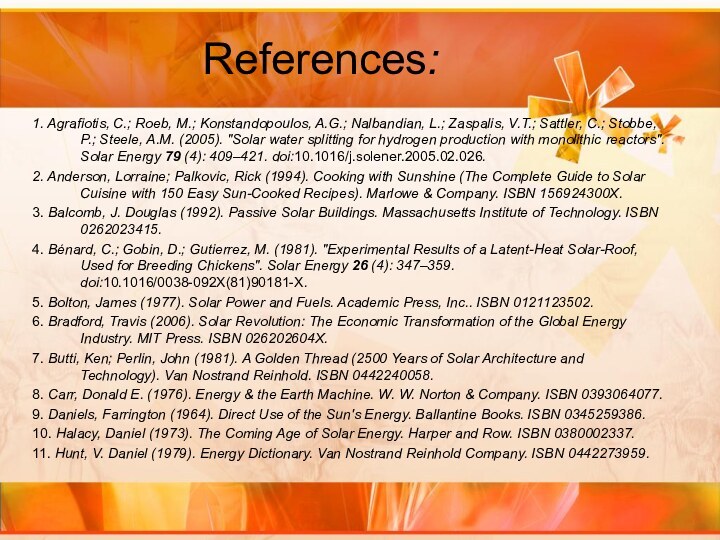
L.; Zaspalis, V.T.; Sattler, C.; Stobbe, P.; Steele, A.M.
(2005). "Solar water splitting for hydrogen production with monolithic reactors". Solar Energy 79 (4): 409–421. doi:10.1016/j.solener.2005.02.026.
2. Anderson, Lorraine; Palkovic, Rick (1994). Cooking with Sunshine (The Complete Guide to Solar Cuisine with 150 Easy Sun-Cooked Recipes). Marlowe & Company. ISBN 156924300X.
3. Balcomb, J. Douglas (1992). Passive Solar Buildings. Massachusetts Institute of Technology. ISBN 0262023415.
4. Bénard, C.; Gobin, D.; Gutierrez, M. (1981). "Experimental Results of a Latent-Heat Solar-Roof, Used for Breeding Chickens". Solar Energy 26 (4): 347–359. doi:10.1016/0038-092X(81)90181-X.
5. Bolton, James (1977). Solar Power and Fuels. Academic Press, Inc.. ISBN 0121123502.
6. Bradford, Travis (2006). Solar Revolution: The Economic Transformation of the Global Energy Industry. MIT Press. ISBN 026202604X.
7. Butti, Ken; Perlin, John (1981). A Golden Thread (2500 Years of Solar Architecture and Technology). Van Nostrand Reinhold. ISBN 0442240058.
8. Carr, Donald E. (1976). Energy & the Earth Machine. W. W. Norton & Company. ISBN 0393064077.
9. Daniels, Farrington (1964). Direct Use of the Sun's Energy. Ballantine Books. ISBN 0345259386.
10. Halacy, Daniel (1973). The Coming Age of Solar Energy. Harper and Row. ISBN 0380002337.
11. Hunt, V. Daniel (1979). Energy Dictionary. Van Nostrand Reinhold Company. ISBN 0442273959.
Слайд 3
12. Karan, Kaul; Greer, Edith; Kasperbauer, Michael; Mahl,

Catherine (2001). "Row Orientation Affects Fruit Yield in Field-Grown
Okra". Journal of Sustainable Agriculture 17 (2/3): 169–174. doi:10.1300/J064v17n02_14.
13. Leon, M.; Kumar, S. (2007). "Mathematical modeling and thermal performance analysis of unglazed transpired solar collectors". Solar Energy 81 (1): 62–75. doi:10.1016/j.solener.2006.06.017.
14. Lieth, Helmut; Whittaker, Robert (1975). Primary Productivity of the Biosphere. Springer-Verlag1. ISBN 0387070834.
15. Martin, Christopher L.; Goswami, D. Yogi (2005). Solar Energy Pocket Reference. International Solar Energy Society. ISBN 0977128202.
16. Mazria, Edward (1979). The Passive Solar Energy Book. Rondale Press. ISBN 0878572384.
17. Meier, Anton; Bonaldi, Enrico; Cella, Gian Mario; Lipinski, Wojciech; Wuillemin, Daniel (2005). "Solar chemical reactor technology for industrial production of lime". Solar Energy 80 (10): 1355–1362. doi:10.1016/j.solener.2005.05.017.
18. Mills, David (2004). "Advances in solar thermal electricity technology". Solar Energy 76 (1-3): 19–31. doi:10.1016/S0038-092X(03)00102-6.
19. Müller, Reto; Steinfeld, A. (2007). "Band-approximated radiative heat transfer analysis of a solar chemical reactor for the thermal dissociation of zinc oxide". Solar Energy 81 (10): 1285–1294. doi:10.1016/j.solener.2006.12.006.
20. Perlin, John (1999). From Space to Earth (The Story of Solar Electricity). Harvard University Press. ISBN 0674010132.
21. Bartlett, Robert (1998). Solution Mining: Leaching and Fluid Recovery of Materials. Routledge. ISBN 9056996339 .
22. Scheer, Hermann (2002). The Solar Economy (Renewable Energy for a Sustainable Global Future). Earthscan Publications Ltd. ISBN 1844070751. http://www.hermannscheer.de/en/index.php?option=com_content&task=view&id=33&Itemid=7
Слайд 4
23. Schittich, Christian (2003). Solar Architecture (Strategies Visions

Concepts). Architektur-Dokumentation GmbH & Co. KG. ISBN 3764307471.
24.
Smil, Vaclav (1991). General Energetics: Energy in the Biosphere and Civilization. Wiley. pp. 369. ISBN 0471629057.
25. Smil, Vaclav (2003). Energy at the Crossroads: Global Perspectives and Uncertainties. MIT Press. pp. 443. ISBN 0262194929.
26. Smil, Vaclav (2006-05-17) (PDF). Energy at the Crossroads. Organisation for Economic Co-operation and Development. ISBN 0262194929. http://www.oecd.org/dataoecd/52/25/36760950.pdf. Retrieved on 2007-09-29.
27. Tabor, H. Z.; Doron, B. (1990). "The Beith Ha'Arava 5 MW(e) Solar Pond Power Plant (SPPP)--Progress Report". Solar Energy 45 (4): 247–253. -092doi:10.1016/0038X(90)90093-R.
28. Tiwari, G. N.; Singh, H. N.; Tripathi, R. (2003). "Present status of solar distillation". Solar Energy 75 (5): 367–373. doi:10.1016/j.solener.2003.07.005.
29. Tritt, T.; Böttner, H.; Chen, L. (2008). "Thermoelectrics: Direct Solar Thermal Energy Conversion". MRS Bulletin 33 (4): 355–372. http://www.mrs.org/s_mrs/bin.asp?CID=12527&DID=208641.
30. Tzempelikos, Athanassios; Athienitis, Andreas K. (2007). "The impact of shading design and control on building cooling and lighting demand". Solar Energy 81 (3): 369–382. doi:10.1016/j.solener.2006.06.015.
31. Vecchia, A.; Formisano, W.; Rosselli, V; Ruggi, D. (1981). "Possibilities for the Application of Solar Energy in the European Community Agriculture". Solar Energy 26 (6): 479–489. doi:10.1016/0038-092X(81)90158-4.
32. Yergin, Daniel (1991). The Prize: The Epic Quest for Oil, Money, and Power. Simon & Schuster. pp. 885. ISBN 0671799329.
33. Zedtwitz, P.v.; Petrasch, J.; Trommer, D.; Steinfeld, A. (2006). "Hydrogen production via the solar thermal decarbonization of fossil fuels". Solar Energy 80 (10): 1333–1337. doi:10.1016/j.solener.2005.06.007.
Слайд 6
A parabolic dish and Stirling engine system, which
concentrates solar energy to produce useful solar power.
Слайд 7
Solar energy is the radiantSolar energy is the
radiant light and heat from the Sun. Solar radiation
along with secondary solar resources such as wind and wave power, hydroelectricity and biomass account for most of the availableSolar energy is the radiant light and heat from the Sun. Solar radiation along with secondary solar resources such as wind and wave power, hydroelectricity and biomass account for most of the available renewableSolar energy is the radiant light and heat from the Sun. Solar radiation along with secondary solar resources such as wind and wave power, hydroelectricity and biomass account for most of the available renewable energy on Earth. Only a minuscule fraction of the available solar energy is used.
Слайд 8
Solar power technologies provide electrical generation by means
of heat engines.
Слайд 9
Solar technologies are broadly characterized as either passive
solar or active solar depending on the way they
capture, convert and distribute sunlight.
Слайд 10
Active solar techniques include the use of photovoltaic
panels, solar thermal collectors, with electrical or mechanical equipment,
to convert sunlight into useful outputs.
Слайд 12
Passive solar techniques include orienting a building to
the Sun, selecting materials with favorable thermal mass or
light dispersing Passive solar techniques include orienting a building to the Sun, selecting materials with favorable thermal mass or light dispersing properties, and designing spaces that naturally circulate air.
Слайд 14
About half the incomingAbout half the incoming solar
energy reaches the Earth's surface.
Слайд 15
The Earth receives 174 petawatts (PW) of incoming
solar radiation (insolation) at the upper atmosphere.
Слайд 16
Approximately 30% is reflected back to space while
the rest is absorbed by clouds, oceans and land
masses.
Слайд 17
The spectrum of solar light at the Earth's
surface is mostly spread across the visible and near-infrared
ranges with a small part in the near-ultraviolet.
Слайд 19
Earth's land surface, oceans and atmosphere absorb solar
radiation, and this raises their temperature. Warm air containing
evaporated Earth's land surface, oceans and atmosphere absorb solar radiation, and this raises their temperature. Warm air containing evaporated water from the oceans rises, causing atmospheric circulationEarth's land surface, oceans and atmosphere absorb solar radiation, and this raises their temperature. Warm air containing evaporated water from the oceans rises, causing atmospheric circulation or convection. When the air reaches a high altitude, where the temperature is low, water vapor condenses into clouds, which rain onto the Earth's surface, completing the water cycle.
Слайд 20
The latentThe latent heat of water condensation amplifies
convection, producing atmospheric phenomena such as wind, cyclones and
anti-cyclones
Слайд 21
Sunlight absorbed by the oceans and land masses
keeps the surface at an average temperature of 14 °C.
By photosynthesis green plants convert solar energy into chemical energy, which produces food, wood and the biomass from which fossil fuels are derived.
Слайд 22
The total solar energy absorbed by Earth's atmosphere,
oceans and land masses is approximately 3,850,000 exajoules (EJ) per
year.
Слайд 23
From the table of resources it would appear
that solar, wind or biomass would be sufficient to
supply all of our energy needs, however, the increased use of biomass has had a negative effect on global warming and dramaticallyFrom the table of resources it would appear that solar, wind or biomass would be sufficient to supply all of our energy needs, however, the increased use of biomass has had a negative effect on global warming and dramatically increased food prices by diverting forests and crops into biofuel production. As intermittentFrom the table of resources it would appear that solar, wind or biomass would be sufficient to supply all of our energy needs, however, the increased use of biomass has had a negative effect on global warming and dramatically increased food prices by diverting forests and crops into biofuel production. As intermittent resources, solar and wind raise other issues.
Слайд 26
Solar energy is not available at night, and
energy storage is an important issue because modern energy
systems usually assume continuous availability of energy.
Слайд 27
Thermal mass systems can store solar energy in
the form of heat at domestically useful temperatures for
daily or seasonal durationsThermal mass systems can store solar energy in the form of heat at domestically useful temperatures for daily or seasonal durations. Thermal storage systems generally use readily available materials with high specific heat capacities such as water, earth and stone. Well-designed systems can lower peak demand, shift time-of-use to off-peak hours and reduce overall heating and cooling requirements.
Слайд 28
Phase change materials such as paraffin wax and
Glauber's saltPhase change materials such as paraffin wax and
Glauber's salt are another thermal storage media. These materials are inexpensive, readily available, and can deliver domestically useful temperatures (approximately 64 °C). The "Dover House" (in Dover, Massachusetts) was the first to use a Glauber's salt heating system, in 1948.
Слайд 29
Solar energy can be stored at high temperatures
using molten salts. Salts are an effective storage medium
because they are low-cost, have a high specific heat capacity and can deliver heat at temperatures compatible with conventional power systems.
Слайд 31
Off-grid PV systems have traditionally used rechargeable Off-grid
PV systems have traditionally used rechargeable batteries to store
excess electricity. With grid-tied systems, excess electricity can be sent to the transmission grid. Net metering programs give these systems a credit for the electricity they deliver to the grid. This credit offsets electricity provided from the grid when the system cannot meet demand, effectively using the grid as a storage mechanism.
Слайд 32
Pumped-storage hydroelectricity stores energy in the form of
water pumped when energy is available from a lower
elevation reservoir to a higher elevation one. The energy is recovered when demand is high by releasing the water to run through a hydroelectric power generator.





